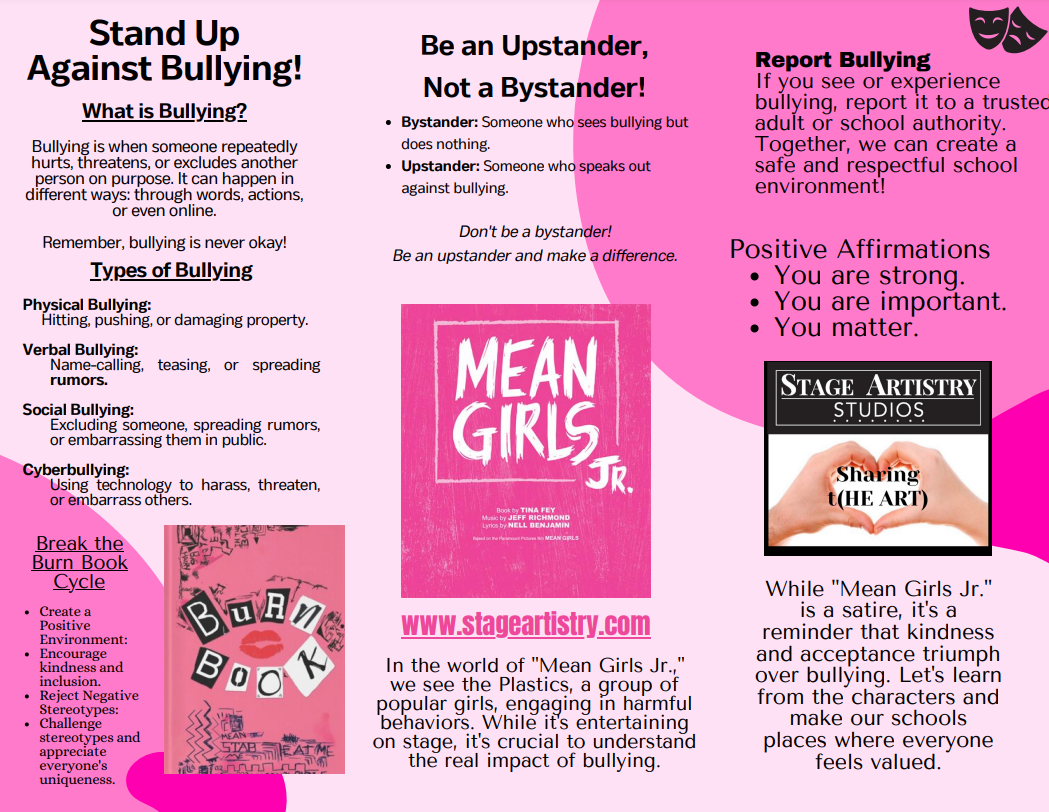

Bristol Community College and Sharing the Art, Inc Present:
United Against Bullying
Building Bridges, Not Barriers: A Bully-Free School Zone
According to the Centers for Disease Control and Prevention (CDC) nearly 14% of public schools report that bullying is a discipline problem occurring daily or at least once a week. Reports of bullying are highest in middle schools (28%) followed by high schools (16%), combined schools (12%), and primary schools (9%).
What is Bullying?
Bullying is repeated aggressive behavior that is intended to cause harm or distress to others. It can take various forms, including physical, verbal, social, or online. Bullying often involves an imbalance of power, where one person uses their influence to intimidate or control another.
Signs a Child Is Being Bullied
Look for changes in the child. However, be aware that not all children who are bullied exhibit warning signs.
Some signs that may point to a bullying problem are:
- Unexplainable injuries
- Lost or destroyed clothing, books, electronics, or jewelry
- Frequent headaches or stomach aches, feeling sick or faking illness
- changes in eating habits, like suddenly skipping meals or binge eating. Kids may come home from school hungry because they did not eat lunch.
- Difficulty sleeping or frequent nightmares
- Declining grades, loss of interest in schoolwork, or not wanting to go to school
- Sudden loss of friends or avoidance of social situations
- Feelings of helplessness or decreased self esteem
- Self-destructive behaviors such as running away from home, harming themselves, or talking about suicide
Signs a Child is Bullying Others
Kids may be bullying others if they:
- Get into physical or verbal fights
- Have friends who bully others
- Are increasingly aggressive
- Get sent to the principal’s office or to detention frequently
- Have unexplained extra money or new belongings
- Blame others for their problems
- Don’t accept responsibility for their actions
- Are competitive and worry about their reputation or popularity
It’s Everyone’s Problem
Bullying is a community concern that requires joint efforts from both parents and schools. This pamphlet emphasizes the importance of collaboration in creating a safe and inclusive environment for our children, where they can flourish without fear of bullying.
The Research
- According to a National Center for Education Statistics (NCES) report, approximately 20% of students aged 12-18 reported being bullied during the school year.
- A study published in the Journal of School Violence found a significant correlation between bullying and lower academic achievement, emphasizing the disruptive effects on a student's ability to learn.
- Research from the American Academy of Pediatrics suggests that children who are bullied may experience long-term mental health issues, including increased risks of anxiety, depression, and even suicidal ideation.
- Studies, such as those published in the Journal of Educational Psychology, emphasize the influential role of bystanders in either perpetuating or preventing bullying, highlighting the importance of encouraging positive intervention.
- The National Center on Safe Supportive Learning Environments emphasizes that a positive school climate, characterized by strong relationships and clear expectations, is crucial for reducing bullying incidents.
- The National Bullying Prevention Center reports that many bullying incidents go unreported, with an estimated 64% of children not reporting incidents to adults.
- Research published in the Scandinavian Journal of Psychology found that “where teachers and parents were involved and aligned, the likelihood of a resolution was greatly improved.”
It’s crucial to involve parents and caretakers in anti-bullying efforts, fortifying the school-family alliance and creating a robust defense against bullying, ensuring a secure environment for all students.
Steps to Consider
- Home-School Partnership: The Foundation of Change
Foster a strong alliance between parents/caretakers and schools to address bullying effectively. Open communication channels, participate in school activities, and work together to create a united front against bullying.
- The Role of Parents and Caretakers: Nurturing Resilience and Empathy
Parents, instill resilience in your children and nurture empathy. Teach them the value of kindness, diversity, and the importance of standing up against bullying. By fostering these qualities at home, you contribute to the overall anti-bullying effort. This message must be conveyed to the students’ caretakers.
- School Initiatives: A Safe Haven for Learning
Schools, implement comprehensive anti-bullying programs. Educate students on the different forms of bullying and provide a platform for open discussions. Establish a reporting system that ensures confidentiality and swift action against bullying incidents.
- Open Lines of Communication: Reporting and Support
Parents and schools must maintain open lines of communication. Encourage students to report bullying incidents without fear of retaliation. Establish a supportive environment where concerns are addressed promptly and effectively.
- Educational Workshops: Equipping Parents/Caretakers and Students
Organize workshops that involve both parents/caretakers and students. These sessions can provide insights into the impact of bullying, strategies for prevention, and ways to promote a culture of inclusivity and respect.
- Cyberbullying Awareness: Navigating the Digital World Together
In today's digital age, parents, caretakers, and schools must collaborate to educate children about responsible online behavior and the dangers of cyberbullying. Monitor online activities, promote positive online interactions, and address any signs of online harassment promptly.
- Empowering Bystanders: Turning Witnesses into Upstanders
Teach children to be active bystanders. Encourage them to speak out against bullying and support those who are targeted. By empowering bystanders, we create a collective force against bullying.
Conclusion
When parents, caretakers, and schools work hand in hand, we create a formidable force against bullying. Let's foster a culture of empathy, resilience, and open communication to ensure our children grow and learn in an environment free from fear. Together, we can build a bully-free zone where every child feels safe, valued, and ready to reach their full potential.
